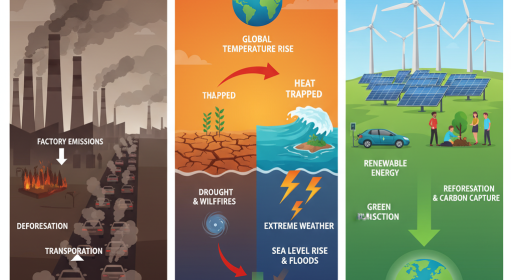In Nigeria, every rainy season or oil spill reminds us that disaster recovery is not enough. Oil spill response in Nigeria. Disaster resilience in Nigeria. The real goal is building a future where disasters cause minimal harm. See how Nigeria can build disaster resilience through climate change adaptation, environmental governance, and smarter disaster risk reduction.
Environment and Climate Change: Smarter Planning
One of Nigeria’s biggest challenges lies in how and where we build. Flood after flood shows the dangers of unregulated urban expansion. Homes and shops keep sprouting up on floodplains and waterways, increasing risks for millions. To reduce this cycle of destruction, urban regulations must be strengthened and enforced so that no new structures block drainage channels or occupy high-risk zones.
At the same time, infrastructure must be smarter and stronger. Dams, sea walls, drainage systems, and culverts need regular maintenance and upgrades to meet the demands of a changing climate. A drainage system built 30 years ago cannot cope with today’s torrential rains. Climate-resilient design, such as elevated roads or adaptive dams, must be built into new projects. Without forward-looking infrastructure planning, the floods and collapses of the past will continue to repeat.
Climate Change in Nigeria: Adaptation and Resilience
Nigeria is one of the countries most exposed to climate extremes, yet it still lacks a finalized National Adaptation Plan. This gap leaves communities vulnerable. A plan that sets clear goals for resilient agriculture, ecosystem restoration, and water management would make a difference.
Global climate funds and technical partnerships are opportunities Nigeria must seize. With access to resources from institutions like the Green Climate Fund, projects such as mangrove replanting in the Niger Delta, drought-resistant crops in the North, and reforestation in erosion-prone states could scale up quickly. Each adaptation project not only reduces risks but also creates jobs and sustains livelihoods.
Disaster Risk Reduction Through Technology and Governance
Disaster warning systems are only as effective as the technology behind them. Nigeria has made progress, but more can be done. SMS-based alerts in local languages, live satellite monitoring, and community-level river gauges can dramatically improve early warnings. For example, a simple text alert about rising river levels could save thousands in towns like Mokwa, where flash floods have recently devastated lives.
Citizen-led monitoring could also transform response. Imagine youth groups managing low-cost river sensors and feeding real-time data to NEMA. With such innovations, communities would no longer wait for disaster agencies to act, they would become active participants in prevention and response.
Strengthening Oil Spill Response
Floods are not Nigeria’s only recurring disaster. Oil spills continue to poison rivers, farmland, and air across the Niger Delta. The National Oil Spill Detection and Response Agency (NOSDRA) is tasked with leading responses, but its power and resources are limited.
For Nigeria to achieve true environmental resilience, NOSDRA must be strengthened with modern detection systems like drones, satellite imaging, and AI-based spill tracking. Faster detection means faster containment, which limits the damage to livelihoods and ecosystems. Stronger legal mandates and better funding would also empower the agency to enforce accountability on oil companies, reducing the frequency and severity of spills.
Governance and Transparency: Winning Back Trust
At the heart of Nigeria’s disaster management gaps lies governance. Billions of naira are allocated to ecological and recovery funds every year, but communities often see little evidence of impact. This erodes trust.
A transparent, public-facing dashboard could change that. Imagine an online platform where citizens track disaster funds in real time; showing how much was allocated, which projects were funded, who the contractors are, and the timelines for completion. Such openness would not only deter corruption but also give communities confidence that recovery and resilience-building are real, not just promises.
“Continuous improvement in disaster management is not about isolated projects, but about building a culture of resilience across the nation. Policies must prevent risky development, climate adaptation must guide farming and infrastructure, technology must enable faster warnings, oil spill response must be strengthened, and governance must be transparent.“
Each flood, each oil spill, each environmental shock must push Nigeria toward lasting change. If every disaster becomes a lesson learned, Nigeria can break the cycle of loss and rebuild a future where nature’s extremes no longer equal human catastrophe. Resilience is not a dream, it is a responsibility, and it begins with collective action today.




